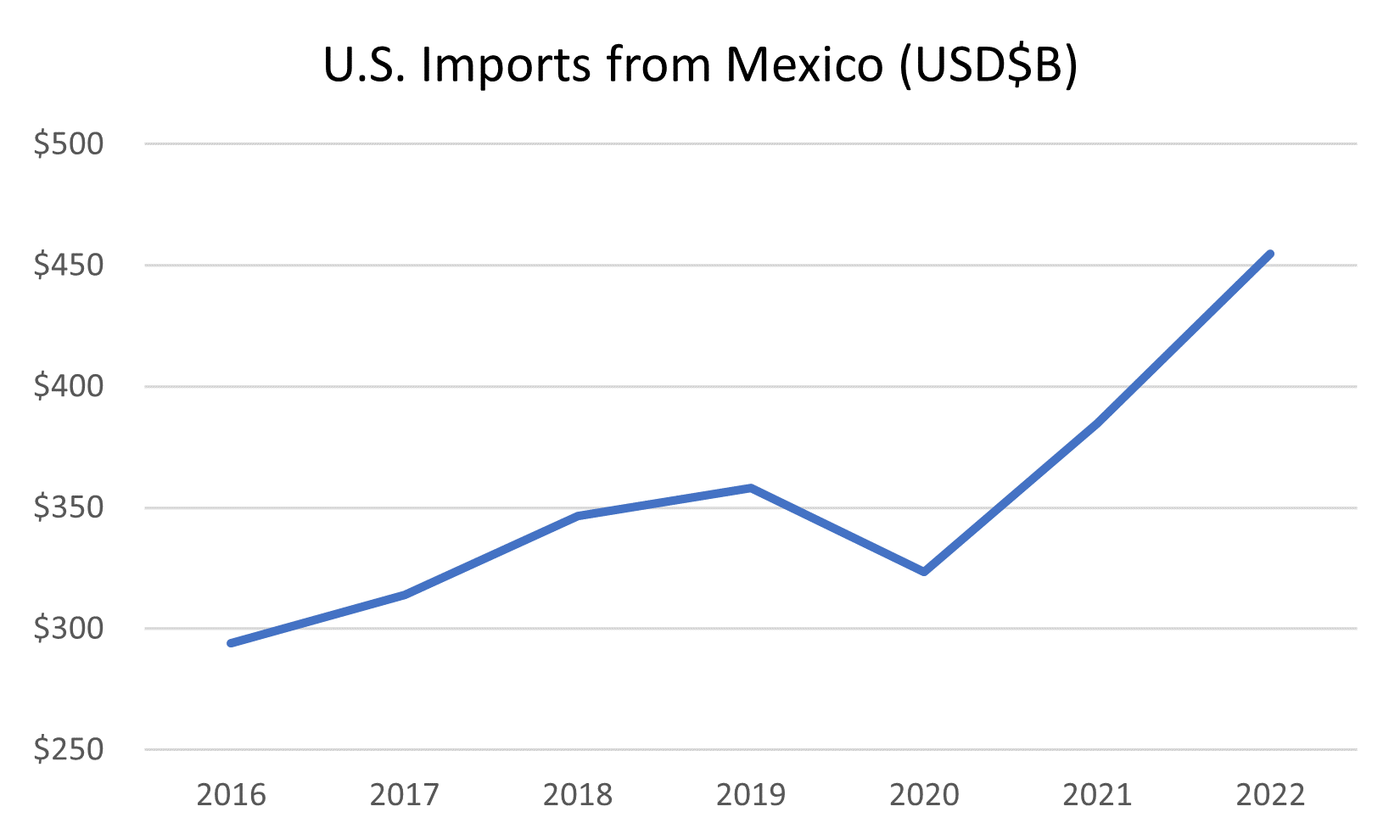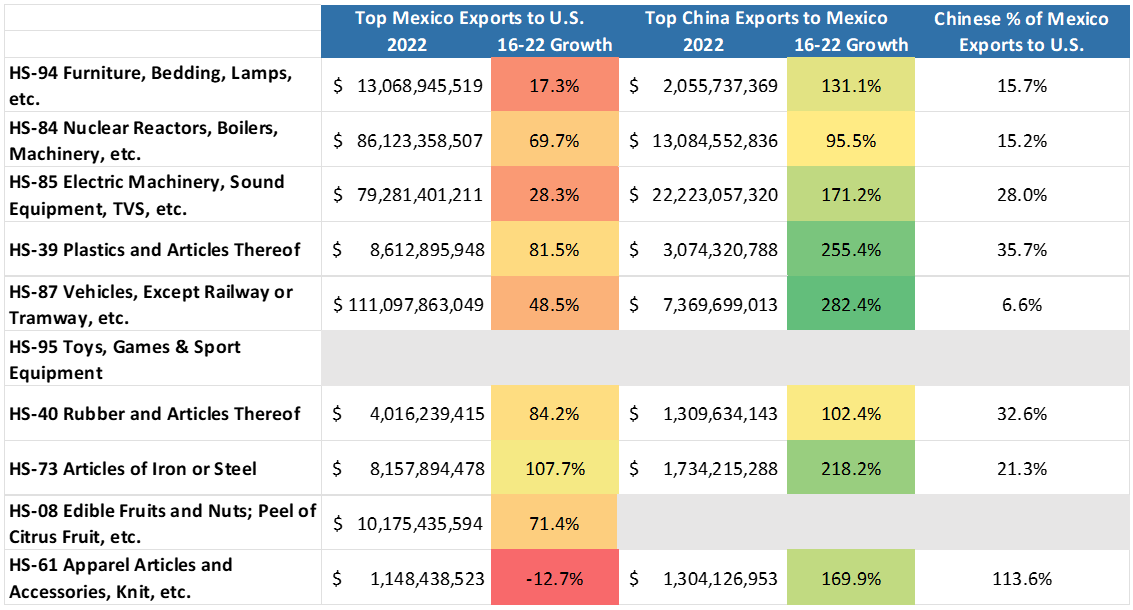The Global Shipping Report
Growth in Mexico’s Exports to U.S. and the Rising Importance of the Chinese Goods Supporting It
Mexico has moved to the forefront of global sourcing conversations since the previous administration began implementing tariffs on China and the pandemic-induced trade flow disruptions. There has been considerable press coverage and announcements by companies such as HP outlining their plans to use Mexico as an incremental or alternate source to China. So how far has Mexico come in this round of trade shifts as a top country of origin (CoO) for the U.S. and how are Chinese goods supporting that growth? To help importers understand the changing trade landscape, Descartes analyzed the top 10 two-digit import commodity categories (HS-2 digits) and their top 10 CoOs to see how Mexico is faring versus the rest of the world and to what degree Chinese goods are becoming an essential part of Mexico’s export growth to the U.S.
Growth in Value of U.S. Imports from Mexico
A seven-year view of the value of U.S. imports from Mexico shows that imports grew 55% during that period. There was relatively steady growth from 2016–2019, a significant decline in 2020 due to the pandemic and accelerated growth in 2021 and 2022 (see Figure 1). The accelerated growth in 2021 and 2022 can also be attributed to pandemic-related demand and inflation, especially in 2022.
Figure 1: Value of U.S. Imports from Mexico 2016–2022

Source: Descartes Datamyne™
Top 10 Commodity Categories and Mexico’s Place as a Top Country of Origin
For the seven-year period from 2016 to 2022, Descartes analyzed 10 of the top goods categories (known as 2-digit HS codes) from largest to smallest as of 2016 (for easy-to-understand HS code examples go to Appendix A) and the related top 10 CoOs for each category and compared them to U.S. imports from Mexico. The goal was to see to what degree Mexico was a significant CoO and whether its market share increased or decreased for each commodity category. Import value (US$) was used as the comparison metric as there isn’t a straightforward way to reconcile physical measures. Key findings include the following:
- Over this period, for the top 10 goods categories, Mexico had:
- Six that grew and increased share;
- Two that grew but lost share; and
- Two that are not in the top 10 CoO.
- Mexico ranks as one of the top three CoOs in six goods categories
- Most of Mexico’s U.S. export growth occurred in 2021 and 2022
Goods Category HS-94 (Furniture, Bedding, etc.)
In 2022, Mexico was the third largest provider (14%) of HS-94 goods (see Figure 2) in terms of value to the U.S. Over a seven-year horizon (2016–2022), the total value of goods from Mexico increased 17% and the greatest percentage growth (16% YoY) was in 2022. The value of U.S. maritime imports, however, increased 43% in the same seven-year period. This would imply that Mexico lost import market share over the last seven years.
Figure 2: Top 10 CoO Analysis for HS-94

Source: Descartes Datamyne™
Goods category HS-84 (Nuclear Reactors, Boilers, Machinery, etc.)
In 2022, Mexico was the second largest provider (19%) of HS-84 goods (see Figure 3) in terms of value to the U.S. Over a seven-year horizon (2016–2022), the total value of goods from Mexico increased 70% and the greatest percentage growth was in 2021 and 2022 (combined 50%). The value of U.S. maritime imports, however, increased only 28% in the same seven-year period. This would imply that Mexico gained significant market share over the last seven years.
Figure 3: Top 10 CoO for HS-84 U.S.

Source: Descartes Datamyne™
Goods category HS-85 (Electric Machinery, Sound Equipment, TVS, etc.)
In 2022, Mexico was the third largest provider (18%) of HS-85 goods (see Figure 4) in terms of value to the U.S. Over a seven-year horizon (2016–2022), the total value of goods from Mexico increased 28% and the greatest percentage growth was in 2021 and 2022 (combined 30%). The value of U.S. maritime imports, however, increased 35% in the same seven-year period. This would imply that Mexico lost import market share over the last seven years.
Figure 4: Top 10 CoO Analysis for HS-85

Source: Descartes Datamyne
Goods category HS-39 (Plastics and Articles Thereof)
In 2022, Mexico was the fourth largest provider (5%) of HS-39 goods (see Figure 5) in terms of value to the U.S. Over a seven-year horizon (2016–2022), the total value of goods from Mexico increased 82% and the greatest percentage growth was in 2021 and 2022 (combined 69%). The value of U.S. maritime imports, however, increased only 53% in the same seven-year period. This would imply that Mexico gained import market share over the last seven years.
Figure 5: Top 10 CoO Analysis for HS-39

Source: Descartes Datamyne
Goods category HS-87 (Vehicles, Except Railway or Tramway, and Parts, etc.)
In 2022, Mexico was the largest provider (38%) of HS-87 goods (see Figure 6) in terms of value to the U.S. Over a seven-year horizon (2016–2022), the total value of goods from Mexico increased 49% and the greatest percentage growth was in 2022 (23% YoY). The value of U.S. maritime imports increased 30% in the same seven-year period. This would imply that Mexico gained import market share over the last seven years. One important point to consider is that $74 billion of the $111 billion in imports from Mexico is from goods (i.e., parts, subassemblies, etc.) that were shipped from the U.S. to Mexico and used in the final assembly of automobiles in Mexico, which were then shipped back to the U.S.
Figure 6: Top 10 CoO Analysis for HS-87

Source: Descartes Datamyne
Goods category HS-95 (Toys, Games & Sport Equipment, etc.)
Mexico is not a top 10 CoO for HS-95 (see Figure 7).
Figure 7: Top 10 CoO Analysis for HS-95

Source: Descartes Datamyne™
Goods category HS-40 (Rubber and Articles Thereof)
In 2022, Mexico was the third largest provider (9%) of HS-40 goods (see Figure 8) in terms of value to the U.S. Over a seven-year horizon (2016–2022), the total value of goods from Mexico increased 84% and the greatest percentage growth was in 2021 and 2022 (combined 68%). The value of U.S. maritime imports increased 33% in the same seven-year period. This would imply that Mexico gained significant market share over the last seven years.
Figure 8: Top 10 CoO Analysis for HS-40

Source: Descartes Datamyne™
Goods category HS-73 (Articles of Iron or Steel)
In 2022, Mexico was the second largest provider (9%) of HS-73 goods (see Figure 9) in terms of value to the U.S. Over a seven-year horizon (2016–2022), the total value of goods from Mexico increased 108% and the greatest percentage growth was in 2021 and 2022 (combined 82%). The value of U.S. maritime imports increased only 15% in the same seven-year period. This would imply that Mexico gained significant market share over the last seven years.
Figure 9: Top 10 CoO Analysis for HS-73

Source: Descartes Datamyne™
Goods category HS-08 (Edible Fruit and Nuts; Peel of Citrus Fruit or Melons)
In 2022, Mexico was the largest provider (41%) of HS-08 goods (see Figure 10) in terms of value to the U.S. Over a seven-year horizon (2016–2022), the total value of goods from Mexico increased 71% and the greatest percentage growth was in 2021 and 2022 (combined 42%). The value of U.S. maritime imports increased only 25% in the same seven-year period. This would imply that Mexico gained significant market share over the last seven years.
Figure 10: Top 10 CoO Analysis for HS-08

Source: Descartes Datamyne™
Goods category, HS-61 (Apparel Articles and Accessories, Knit or Crochet)
Mexico is not a top 10 CoO for HS-61 (see Figure 11).
Figure 11: Top 10 CoO Analysis for HS-61

Source: Descartes Datamyne™
To access other articles that track port congestion monthly, visit the
Global Shipping Resource Center
White Papers
Survey Uncovers Supply Chain Strategies of Top Performing Companies
Surviving Peak Season and Beyond: The Essential Guide to Supply Chain Resiliency

Executive Vice President of Industry and Services
Descartes Systems Group
The Must-Read Guide on U.S. Maritime Ports

See the impact port congestion has had on U.S. imports, and gain insights into how to mitigate risks in your supply chain.
Stay Informed. Download the Report.
The China Factor in the Rise of U.S. Imports from Mexico
Descartes wanted to understand to what extent Chinese goods are contributing to the growth of U.S. imports from Mexico and, in particular, since the previous administration’s tariff actions against China. As previously stated, U.S. imports from Mexico grew 54% from 2016 to 2022. For the same period, however, Mexico imports from China grew 138%, a significant percentage unlikely to have been completely absorbed by the Mexican economy which only grew 3.4% over that period1. Instead, these imports were most likely used to produce products in Mexico that were destined for the U.S. (see Figure 12). For clarification, this growth is being driven not just by Chinese companies, but any multinational using Mexico as a lower-cost manufacturing source for U.S.-bound goods, such as in the HP announcement.
Figure 12: Mexico Imports from China

Source: Descartes Datamyne™
To drill down further, Descartes analyzed the top 10 HS-2 commodity groups to see how Mexico imports from China compared to U.S. imports from Mexico. It’s apparent that China now represents a significant percentage of the value of U.S. imports from Mexico. For HS-87 (Vehicles, etc.) in particular, the percentage of Chinese exports to Mexico is most likely underrepresented as U.S. imports from Mexico include vehicles, not just parts, and account for multiple moves across the U.S. and Mexican borders. In Figure 13, HS-95 is blank because Mexico was not in the top 10 CoOs for U.S. imports and HS-61 is partially blank because China was not in the top 10 CoOs for Mexico imports.
Figure 13: Top HS-2 Commodity Group Comparison for U.S. Imports from Mexico and Mexico Imports from China

Source: Descartes Datamyne™
The analysis shows that Mexico’s position as one of the top countries of origin for U.S. imports continues to grow and that it accelerated in the last two years as a result of U.S.-imposed tariffs on China and the pandemic trade flow disruptions. In a number of major commodity groups, Mexico is either the top source for the U.S. or a strong alternative. Additionally, Mexico imports of goods from China are accelerating at an even faster rate and taking a strong position in supporting Mexico’s export growth to the U.S.
Appendix A: Examples of Goods from 2-Digit HS Codes Used in This Report

1 Source: World Bank
Source: Descartes Datamyne™
How Descartes Can Help
Descartes Datamyne delivers business intelligence with comprehensive, accurate, up-to-date, import and export information.
Our multinational trade data assets can be used to trace global supply chains and our bill-of-lading trade data – with cross-references to company profiles and customs information – can help businesses identify and qualify new sources. Ask us for a free, no obligation demonstration of our data on a product or trade commodity of your choosing – and keep the custom research we create with our compliments.

